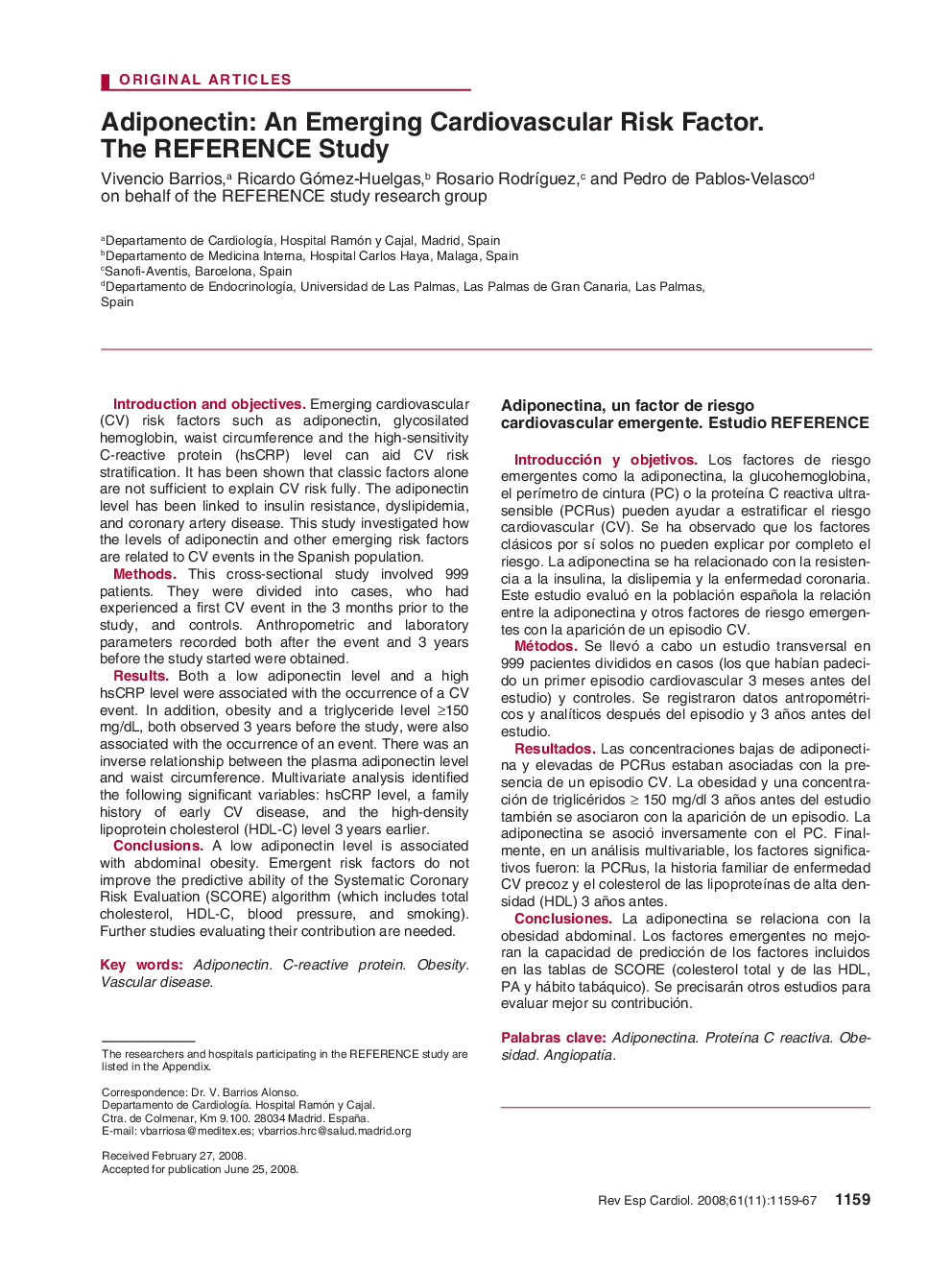| Article ID | Journal | Published Year | Pages | File Type |
|---|---|---|---|---|
| 3018637 | Revista Española de Cardiología (English Edition) | 2008 | 9 Pages |
Introduction and objectivesEmerging cardiovascular (CV) risk factors such as adiponectin, glycosilated hemoglobin, waist circumference and the high-sensitivity C-reactive protein (hsCRP) level can aid CV risk stratification. It has been shown that classic factors alone are not sufficient to explain CV risk fully. The adiponectin level has been linked to insulin resistance, dyslipidemia, and coronary artery disease. This study investigated how the levels of adiponectin and other emerging risk factors are related to CV events in the Spanish population.MethodsThis cross-sectional study involved 999 patients. They were divided into cases, who had experienced a first CV event in the 3 months prior to the study, and controls. Anthropometric and laboratory parameters recorded both after the event and 3 years before the study started were obtained.ResultsBoth a low adiponectin level and a high hsCRP level were associated with the occurrence of a CV event. In addition, obesity and a triglyceride level ≥150 mg/dL, both observed 3 years before the study, were also associated with the occurrence of an event. There was an inverse relationship between the plasma adiponectin level and waist circumference. Multivariate analysis identified the following significant variables: hsCRP level, a family history of early CV disease, and the high-density lipoprotein cholesterol (HDL-C) level 3 years earlier.ConclusionsA low adiponectin level is associated with abdominal obesity. Emergent risk factors do not improve the predictive ability of the Systematic Coronary Risk Evaluation (SCORE) algorithm (which includes total cholesterol, HDL-C, blood pressure, and smoking). Further studies evaluating their contribution are needed.
Introducción y objetivosLos factores de riesgo emergentes como la adiponectina, la glucohemoglobina, el perímetro de cintura (PC) o la proteína C reactiva ultrasensible (PCRus) pueden ayudar a estratificar el riesgo cardiovascular (CV). Se ha observado que los factores clásicos por sí solos no pueden explicar por completo el riesgo. La adiponectina se ha relacionado con la resistencia a la insulina, la dislipemia y la enfermedad coronaria. Este estudio evaluó en la población española la relación entre la adiponectina y otros factores de riesgo emergentes con la aparición de un episodio CV.MétodosSe llevó a cabo un estudio transversal en 999 pacientes divididos en casos (los que habían padecido un primer episodio cardiovascular 3 meses antes del estudio) y controles. Se registraron datos antropométricos y analíticos después del episodio y 3 años antes del estudio.ResultadosLas concentraciones bajas de adiponectina y elevadas de PCRus estaban asociadas con la presencia de un episodio CV. La obesidad y una concentración de triglicéridos ≥ 150 mg/dl 3 años antes del estudio también se asociaron con la aparición de un episodio. La adiponectina se asoció inversamente con el PC. Finalmente, en un análisis multivariable, los factores significativos fueron: la PCRus, la historia familiar de enfermedad CV precoz y el colesterol de las lipoproteínas de alta densidad (HDL) 3 años antes.ConclusionesLa adiponectina se relaciona con la obesidad abdominal. Los factores emergentes no mejoran la capacidad de predicción de los factores incluidos en las tablas de SCORE (colesterol total y de las HDL, PA y hábito tabáquico). Se precisarán otros estudios para evaluar mejor su contribución.
